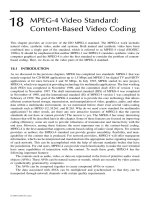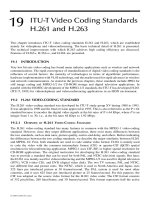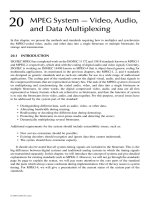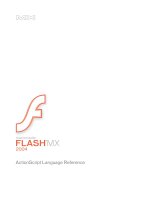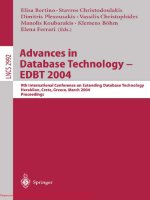Tài liệu Image and Videl Comoression P1 pptx
Bạn đang xem bản rút gọn của tài liệu. Xem và tải ngay bản đầy đủ của tài liệu tại đây (4.06 MB, 28 trang )
© 2000 by CRC Press LLC
Section I
Fundamentals
© 2000 by CRC Press LLC
1
Introduction
Image and video data compression* refers to a process in which the amount of data used to represent
image and video is reduced to meet a bit rate requirement (below or at most equal to the maximum
available bit rate), while the quality of the reconstructed image or video satisfies a requirement for
a certain application and the complexity of computation involved is affordable for the application.
The block diagram in Figure 1.1 shows the functionality of image and video data compression in
visual transmission and storage. Image and video data compression has been found to be necessary
in these important applications, because the huge amount of data involved in these and other
applications usually greatly exceeds the capability of today’s hardware despite rapid advancements
in the semiconductor, computer, and other related industries.
It is noted that information and data are two closely related yet different concepts. Data represent
information, and the quantity of data can be measured. In the context of digital image and video,
data are usually measured by the number of binary units (bits). Information is defined as knowledge,
facts, and news according to the Cambridge International Dictionary of English. That is, while data
are the
representations
of knowledge, facts, and news, information
is
the knowledge, facts, and
news. Information, however, may also be quantitatively measured.
The bit rate (also known as the coding rate), is an important parameter in image and video
compression and is often expressed in a unit of bits per second, which is suitable in visual
communication. In fact, an example in Section 1.1 concerning videophony (a case of visual trans-
mission) uses the bit rate in terms of bits per second (bits/sec, or simply bps). In the application
of image storage, the bit rate is usually expressed in a unit of bits per pixel (bpp). The term pixel
is an abbreviation for picture element and is sometimes referred to as pel. In information source
coding, the bit rate is sometimes expressed in a unit of bits per symbol. In Section 1.4.2, when
discussing noiseless source coding theorem, we consider the bit rate as the average length of
codewords in the unit of bits per symbol.
The required quality of the reconstructed image and video is application dependent. In medical
diagnoses and some scientific measurements, we may need the reconstructed image and video to
mirror the original image and video. In other words, only reversible, information-preserving
schemes are allowed. This type of compression is referred to as lossless compression. In applications
such as motion pictures and television (TV), a certain amount of information loss is allowed. This
type of compression is called lossy compression.
From its definition, one can see that image and video data compression involves several
fundamental concepts including information, data, visual quality of image and video, and compu-
tational complexity. This chapter is concerned with several fundamental concepts in image and
video compression. First, the necessity as well as the feasibility of image and video data compression
are discussed. The discussion includes the utilization of several types of redundancies inherent in
image and video data, and the visual perception of the human visual system (HVS). Since the
quality of the reconstructed image and video is one of our main concerns, the subjective and
objective measures of visual quality are addressed. Then we present some fundamental information
theory results, considering that they play a key role in image and video compression.
* In this book, the terms image and video data compression, image and video compression, and image and video coding
are synonymous.
© 2000 by CRC Press LLC
1.1 PRACTICAL NEEDS FOR IMAGE AND VIDEO COMPRESSION
Needless to say, visual information is of vital importance if human beings are to perceive, recognize,
and understand the surrounding world. With the tremendous progress that has been made in
advanced technologies, particularly in very large scale integrated (VLSI) circuits, and increasingly
powerful computers and computations, it is becoming more than ever possible for video to be
widely utilized in our daily lives. Examples include videophony, videoconferencing, high definition
TV (HDTV), and the digital video disk (DVD), to name a few.
Video as a sequence of video frames, however, involves a huge amount of data. Let us take a
look at an illustrative example. Assume the present switch telephone network (PSTN) modem can
operate at a maximum bit rate of 56,600 bits per second. Assume each video frame has a resolution
of 288 by 352 (288 lines and 352 pixels per line), which is comparable with that of a normal TV
picture and is referred to as common intermediate format (CIF). Each of the three primary colors
RGB (red, green, blue) is represented for 1 pixel with 8 bits, as usual, and the frame rate in
transmission is 30 frames per second to provide a continuous motion video. The required bit rate,
then, is 288
¥
352
¥
8
¥
3
¥
30 = 72,990,720 bps. Therefore, the ratio between the required bit
rate and the largest possible bit rate is about 1289. This implies that we have to compress the video
data by at least 1289 times in order to accomplish the transmission described in this example. Note
that an audio signal has not yet been accounted for yet in this illustration.
With increasingly complex video services such as 3-D movies and 3-D games, and high video
quality such as HDTV, advanced image and video data compression is necessary. It becomes an
enabling technology to bridge the gap between the required huge amount of video data and the
limited hardware capability.
1.2 FEASIBILITY OF IMAGE AND VIDEO COMPRESSION
In this section we shall see that image and video compression is not only a necessity for the rapid
growth of digital visual communications, but it is also feasible. Its feasibility rests with two types
of redundancies, i.e., statistical redundancy and psychovisual redundancy. By eliminating these
redundancies, we can achieve image and video compression.
1.2.1 S
TATISTICAL
R
EDUNDANCY
Statistical redundancy can be classified into two types: interpixel redundancy and coding redun-
dancy. By interpixel redundancy we mean that pixels of an image frame and pixels of a group of
successive image or video frames are not statistically independent. On the contrary, they are
correlated to various degrees. (Note that the differences and relationships between image and video
sequences are discussed in Chapter 10, when we begin to discuss video compression.) This type
of interpixel correlation is referred to as interpixel redundancy. Interpixel redundancy can be divided
into two categories, spatial redundancy and temporal redundancy. By coding redundancy we mean
the statistical redundancy associated with coding techniques.
FIGURE 1.1
Image and video compression for visual transmission and storage.
© 2000 by CRC Press LLC
1.2.1.1 Spatial Redundancy
Spatial redundancy represents the statistical correlation between pixels within an image frame.
Hence it is also called intraframe redundancy.
It is well known that for most properly sampled TV signals the normalized autocorrelation
coefficients along a row (or a column) with a one-pixel shift is very close to the maximum value
of 1. That is, the intensity values of pixels along a row (or a column) have a very high autocorrelation
(close to the maximum autocorrelation) with those of pixels along the same row (or the same
column), but shifted by a pixel. This does not come as a surprise because most of the intensity
values change continuously from pixel to pixel within an image frame except for the edge regions.
This is demonstrated in Figure 1.2. Figure 1.2(a) is a normal picture — a boy and a girl in a park,
and is of a resolution of 883 by 710. The intensity profiles along the 318th row and the 262nd
column are depicted in Figures 1.2(b) and (c), respectively. For easy reference, the positions of the
318th row and 262nd column in the picture are shown in Figure 1.2(d). That is, the vertical axis
represents intensity values, while the horizontal axis indicates the pixel position within the row or
the column. These two plots (shown in Figures 1.2(b) and 1.2(c)) indicate that intensity values
often change gradually from one pixel to the other along a row and along a column.
The study of the statistical properties of video signals can be traced back to the 1950s. Knowing
that we must study and understand redundancy in order to remove redundancy, Kretzmer designed
some experimental devices such as a picture autocorrelator and a probabiloscope to measure several
statistical quantities of TV signals and published his outstanding work in (Kretzmer, 1952). He
found that the autocorrelation in both horizontal and vertical directions exhibits similar behaviors,
as shown in Figure 1.3. Autocorrelation functions of several pictures with different complexities
were measured. It was found that from picture to picture, the shape of the autocorrelation curves
ranges from remarkably linear to somewhat exponential. The central symmetry with respect to the
vertical axis and the bell-shaped distribution, however, remains generally the same. When the pixel
shifting becomes small, it was found that the autocorrelation is high. This “local” autocorrelation
can be as high as 0.97 to 0.99 for one- or two-pixel shifting. For very detailed pictures, it can be
from 0.43 to 0.75. It was also found that autocorrelation generally has no preferred direction.
The Fourier transform of autocorrelation, the power spectrum, is known as another important
function in studying statistical behavior. Figure 1.4 shows a typical power spectrum of a television
signal (Fink, 1957; Connor et al., 1972). It is reported that the spectrum is quite flat until 30 kHz
for a broadcast TV signal. Beyond this line frequency the spectrum starts to drop at a rate of around
6 dB per octave. This reveals the heavy concentration of video signals in low frequencies, consid-
ering a nominal bandwidth of 5 MHz.
Spatial redundancy implies that the intensity value of a pixel can be
guessed
from that of its
neighboring pixels. In other words, it is not necessary to represent each pixel in an image frame
independently. Instead, one can predict a pixel from its neighbors. Predictive coding, also known
as differential coding, is based on this observation and is discussed in Chapter 3. The direct
consequence of recognition of spatial redundancy is that by removing a large amount of the
redundancy (or utilizing the high correlation) within an image frame, we may save a lot of data in
representing the frame, thus achieving data compression.
1.2.1.2 Temporal Redundancy
Temporal redundancy is concerned with the statistical correlation between pixels from successive
frames in a temporal image or video sequence. Therefore, it is also called interframe redundancy.
Consider a temporal image sequence. That is, a camera is fixed in the 3-D world and it takes
pictures of the scene one by one as time goes by. As long as the time interval between two
consecutive pictures is short enough, i.e., the pictures are taken densely enough, we can imagine
that the similarity between two neighboring frames is strong. Figures 1.5(a) and (b) show, respectively,
© 2000 by CRC Press LLC
FIGURE 1.2
(a) A picture of “Boy and Girl,” (b) Intensity profile along 318th row, (c) Intensity profile
along 262nd column, (d) Positions of 318th row and 262nd column.
© 2000 by CRC Press LLC
the 21st and 22nd frames of the “Miss America” sequence. The frames have a resolution of 176
by 144. Among the total of 25,344 pixels, only 3.4% change their gray value by more than 1% of
the maximum gray value (255 in this case) from the 21st frame to the 22nd frame. This confirms
an observation made in (Mounts, 1969): for a videophone-like signal with moderate motion in the
scene, on average, less than 10% of pixels change their gray values between two consecutive frames
by an amount of 1% of the peak signal. The high interframe correlation was reported in (Kretzmer,
1952). There, the autocorrelation between two adjacent frames was measured for two typical
motion-picture films. The measured autocorrelations are 0.80 and 0.86. In summary, pixels within
successive frames usually bear a strong similarity or correlation.
As a result, we may predict a frame from its neighboring frames along the temporal dimension.
This is referred to as interframe predictive coding and is discussed in Chapter 3. A more precise,
hence, more efficient interframe predictive coding scheme, which has been in development since
FIGURE 1.2
(continued)
FIGURE 1.3
Autocorrelation in the horizontal direction for some pictures. (After Kretzmer, 1952.)
© 2000 by CRC Press LLC
the 1980s, uses motion analysis. That is, it considers that the changes from one frame to the next
are mainly due to the motion of some objects in the frame. Taking this motion information into
consideration, we refer to the method as motion compensated predictive coding. Both interframe
correlation and motion compensated predictive coding are covered in detail in Chapter 10.
Removing a large amount of temporal redundancy leads to a great deal of data compression.
At present, all the international video coding standards have adopted motion compensated predictive
coding, which has been a vital factor to the increased use of digital video in digital media.
1.2.1.3 Coding Redundancy
As we discussed, interpixel redundancy is concerned with the correlation between pixels. That is,
some information associated with pixels is redundant. The psychovisual redundancy, which is
discussed in the next subsection, is related to the information that is psychovisually redundant, i.e.,
to which the HVS is not sensitive. Hence, it is clear that both the interpixel and psychovisual
redundancies are somehow associated with some information contained in the image and video.
Eliminating these redundancies, or utilizing these correlations, by using fewer bits to represent the
FIGURE 1.4
Typical power spectrum of a TV broadcast signal. (Adapted from Fink, D.G.,
Television
Engineering Handbook,
McGraw-Hill, New York, 1957.)
FIGURE 1.5
(a) The 21st frame, and (b) 22nd frame of the “Miss America” sequence.
© 2000 by CRC Press LLC
information results in image and video data compression. In this sense, the coding redundancy is
different. It has nothing to do with information redundancy but with the representation of infor-
mation, i.e., coding itself. To see this, let us take a look at the following example.
One illustrative example is provided in Table 1.1. The first column lists five distinct symbols
that need to be encoded. The second column contains occurrence probabilities of these five symbols.
The third column lists code 1, a set of codewords obtained by using uniform-length codeword
assignment. (This code is known as the natural binary code.) The fourth column shows code 2, in
which each codeword has a variable length. Therefore, code 2 is called the variable-length code.
It is noted that the symbol with a higher occurrence probability is encoded with a shorter length.
Let us examine the efficiency of the two different codes. That is, we will examine which one
provides a shorter average length of codewords. It is obvious that the average length of codewords
in code 1,
L
avg
,1
, is three bits. The average length of codewords in code 2,
L
avg
,2
, can be calculated
as follows.
(1.1)
Therefore, it is concluded that code 2 with variable-length coding is more efficient than code 1
with natural binary coding.
From this example, we can see that for the same set of symbols different codes may perform
differently. Some may be more efficient than others. For the same amount of information, code 1
contains some redundancy. That is, some data in code 1 are not necessary and can be removed
without any effect. Huffman coding and arithmetic coding, two variable-length coding techniques,
will be discussed in Chapter 5.
From the study of coding redundancy, it is clear that we should search for more efficient coding
techniques in order to compress image and video data.
1.2.2 P
SYCHOVISUAL
R
EDUNDANCY
While interpixel redundancy inherently rests in image and video data, psychovisual redundancy
originates from the characteristics of the human visual system (HVS).
It is known that the HVS perceives the outside world in a rather complicated way. Its response
to visual stimuli is not a linear function of the strength of some physical attributes of the stimuli,
such as intensity and color. HVS perception is different from camera sensing. In the HVS, visual
information is not perceived equally; some information may be more important than other infor-
mation. This implies that if we apply fewer data to represent less important visual information,
perception will not be affected. In this sense, we see that some visual information is psychovisually
redundant. Eliminating this type of psychovisual redundancy leads to data compression.
In order to understand this type of redundancy, let us study some properties of the HVS. We
may model the human vision system as a cascade of two units (Lim, 1990), as depicted in Figure 1.6.
TABLE 1.1
An Illustrative Example
Symbol Occurrence Probability Code 1 Code 2
a
1
0.1 000 0000
a
2
0.2 001 01
a
3
0.5 010 1
a
4
0.05 011 0001
a
5
0.15 100 001
L
avg,
.... ..
2
4 01 2 02 1 05 4 005 3 015 195=¥ +¥ +¥ +¥ +¥ = bits per symbol
© 2000 by CRC Press LLC
The first one is a low-level processing unit which converts incident light into a neural signal. The
second one is a high-level processing unit, which extracts information from the neural signal. While
much research has been carried out to investigate low-level processing, high-level processing
remains wide open. The low-level processing unit is known as a nonlinear system (approximately
logarithmic, as shown below). While a great body of literature exists, we will limit our discussion
only to video compression-related results. That is, several aspects of the HVS which are closely
related to image and video compression are discussed in this subsection. They are luminance
masking, texture masking, frequency masking, temporal masking, and color masking. Their rele-
vance in image and video compression is addressed. Finally, a summary is provided in which it is
pointed out that all of these features can be unified as one: differential sensitivity. This seems to
be the most important feature of human visual perception.
1.2.2.1 Luminance Masking
Luminance masking concerns the brightness perception of the HVS, which is the most fundamental
aspect among the five to be discussed here. Luminance masking is also referred to as
luminance
dependence
(Connor et al., 1972), and
contrast masking
(Legge and Foley, 1980, Watson, 1987).
As pointed in (Legge and Foley, 1980), the term
masking
usually refers to a destructive interaction
or interference among stimuli that are closely coupled in time or space. This may result in a failure
in detection, or errors in recognition. Here, we are mainly concerned with the detectability of one
stimulus when another stimulus is present simultaneously. The effect of one stimulus on the
detectability of another, however, does not have to decrease detectability. Indeed, there are some
cases in which a low-contrast masker increases the detectability of a signal. This is sometimes
referred to as
facilitation
, but in this discussion we only use the term masking.
Consider the monochrome image shown in Figure 1.7. There, a uniform disk-shaped object
with a gray level (intensity value)
I
1
is imposed on a uniform background with a gray level
I
2
. Now
the question is under what circumstances can the disk-shaped object be discriminated from the
background by the HVS? That is, we want to study the effect of one stimulus (the background in
this example, the masker) on the detectability of another stimulus (in this example, the disk). Two
extreme cases are obvious. That is, if the difference between the two gray levels is quite large, the
HVS has no problem with discrimination, or in other words the HVS notices the object from the
background. If, on the other hand, the two gray levels are the same, the HVS cannot identify the
existence of the object. What we are concerned with here is the critical threshold in the gray level
difference for discrimination to take place.
If we define the threshold
D
I
as such a gray level difference
D
I
=
I
1
–
I
2
that the object can be
noticed by the HVS with a 50% chance, then we have the following relation, known as
contrast
sensitivity function
, according to Weber’s law:
(1.2)
FIGURE 1.6
A two-unit cascade model of the human visual system (HVS).
DI
I
ª constant
© 2000 by CRC Press LLC
where the constant is about 0.02. Weber’s law states that for a relatively very wide range of I, the
threshold for discrimination,
D
I
, is directly proportional to the intensity
I
. The implication of this
result is that when the background is bright, a larger difference in gray levels is needed for the
HVS to discriminate the object from the background. On the other hand, the intensity difference
required could be smaller if the background is relatively dark. It is noted that Equation 1.2 implies
a logarithmic response of the HVS, and Weber’s law holds for all other human senses as well.
Further research has indicated that the luminance threshold
D
I
increases more slowly than is
predicted by Weber’s law. Some more accurate contrast sensitivity functions have been presented
in the literature. In (Legge and Foley, 1980), it was reported that an exponential function replaces
the linear relation in Weber’s law. The following exponential expression is reported in (Watson,
1987).
(1.3)
where
I
0
is the luminance detection threshold when the gray level of the background is equal to
zero, i.e.,
I
= 0, and
a
is a constant, approximately equal to 0.7.
Figure 1.8 shows a picture uniformly corrupted by additive white Gaussian noise (AWGN). It
can be observed that the noise is more visible in the dark areas than in the bright areas if comparing,
for instance, the dark portion and the bright portion of the cloud above the bridge. This indicates
that noise filtering is more necessary in the dark areas than in the bright areas. The lighter areas
can accommodate more additive noise before the noise becomes visible. This property has found
application in embedding digital watermarks (Huang and Shi, 1998).
The direct impact that luminance masking has on image and video compression is related to
quantization, which is covered in detail in the next chapter. Roughly speaking, quantization is a
process that converts a continuously distributed quantity into a set of many finitely distinct quan-
tities. The number of these distinct quantities (known as quantization levels) is one of the keys in
quantizer design. It significantly influences the resulting bit rate and the quality of the reconstructed
image and video. An effective quantizer should be able to minimize the visibility of quantization
error. The contrast sensitivity function provides a guideline in analysis of the visibility of quanti-
zation error. Therefore, it can be applied to quantizer design. Luminance masking suggests a
nonuniform quantization scheme that takes the contrast sensitivity function into consideration. One
such example was presented in (Watson, 1987).
FIGURE 1.7
A uniform object with gray level I
1
imposed on a uniform background with gray level I
2
.
DII
I
I
=◊
Ê
Ë
Á
ˆ
¯
˜
Ï
Ì
Ô
Ó
Ô
¸
˝
Ô
˛
Ô
0
0
1max , ,
a
© 2000 by CRC Press LLC
1.2.2.2 Texture Masking
Texture masking is sometimes also called
detail dependence
(Connor et al., 1972),
spatial masking
(Netravali and Presada, 1977; Lim, 1990), or
activity masking
(Mitchell et al., 1997). It states that
the discrimination threshold increases with increasing picture detail. That is, the stronger the texture,
the larger the discrimination threshold. In Figure 1.8, it can be observed that the additive random
noise is less pronounced in the strongly textured area than in the smooth area if comparing, for
instance, the dark portion of the cloud (the upper-right corner of the picture) with the water area
(the lower right corner of the picture). This is a confirmation of texture masking.
In Figure 1.9(b), the number of quantization levels decreases from 256, as in Figure 1.9(a), to
16. That is, we use only four bits instead of eight bits to represent the intensity value for each pixel.
FIGURE 1.8
The Burrard bridge in Vancouver. (a) Original picture (courtesy of Minhuai Shi). (b) Picture
uniformly corrupted by additive white Gaussian noise.

